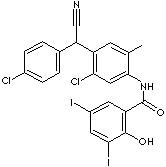| CAS
NO. |
57808-65-8 |

|
| EINECS
NO. |
260-967-1 |
| FORMULA |
C22H14Cl2I2N2O2 |
| MOL
WT. |
663.08 |
|
H.S.
CODE
|
|
|
TOXICITY
|
|
| SMILES |
|
| SYNONYMS |
|
| 5'-Chloro-alpha4-(p-chlorophenyl)-alpha4-cyano-3,5-diiodo-2',4'-salicyloxylidide;
N-[5-Choloro-4-
[(4-Chlorophenyl) Cyanomethyl]-2-Methylpheny]- 2-Hydroxy-3-5-
Diiodobenzamide; |
| CLASSIFICATION
|
|
|
PHYSICAL
AND CHEMICAL PROPERTIES
|
| PHYSICAL
STATE |
white to yellowish
crystalline powder |
| MELTING
POINT |
210
- 220C |
| BOILING
POINT |
|
| SPECIFIC
GRAVITY |
|
| SOLUBILITY
IN WATER |
Insoluble |
| pH |
|
| VAPOR
DENSITY |
|
| AUTOIGNITION |
|
| NFPA
RATINGS |
|
|
REFRACTIVE
INDEX
|
|
| FLASH
POINT |
|
| STABILITY |
Stable
under ordinary conditions |
|
APPLICATIONS
|
| Closantel is a broad-spectrum salicylanilide anthelmintic used as
anti-trematode, anti-nematodes and anti-arthropods in combination with
benzimidazole anthelmintic such as mebendazole. It is a white to yellowish
powder; insoluble in water; soluble in dimethylformamide and acetone; melting
point 215 C. Its chemical designation is
5'-Chloro-alpha4-(p-chlorophenyl)- alpha4-cyano- 3,5-diiodo-2',4'-salicyloxylidide.
Closantel is used as an acaricide. Anthelmintic (also spelled anthelminthic) is a chemical substance used to expel
or destroy tapeworms in domestic animals. Some common anthelmintic active
ingredients classified by chemical structure include;
- Benzimidazoles
- Albendazole
(CAS #: 54965-21-8)
- Fenbendazole
(CAS #: 43210-67-9)
- Mebendazole
(CAS #: 31431-39-7)
- Oxfendazole
(CAS #: 53716-50-0)
- Oxibendazole
((CAS #: 20559-55-1)
- Triclabendazole (CAS #: 68786-66-3)
- Diphenylsulfides
- Bithionol (CAS
#:97-18-7)
- Febantel (CAS
#: 58306-30-2)
- Hexahydropyrazines
- Diethylcarbamazine (CAS
#: 90-89-1)
- Piperazine
(CAS #: 110-85-0)
- Praziquantel
(CAS #: 55268-74-1)
- Imidazothiazoles
-
Levamisole (CAS
#: 14769-73-4)
- Tetramisol (CAS
#: 5036-02-2)
- Macrocylic
Lactones
- Abamectin
(CAS #: 71751-41-2)
- Doramectin
(CAS #: 117704-25-3)
- Eprinomectin (CAS
#: 123997-26-2)
- Eprinomectin B1a (CAS#:
133305-88-1)
- Eprinomectin B1b (CAS
#: 133305-89-2)
- Ivermectin (CAS
#: 70288-86-7)
- Ivermectin B1a (CAS #: 70161-11-4)
- Ivermectin B1b (CAS #: 70209-81-3)
- Moxidectin
(CAS #: 113507-06-5)
- Salicylanilide
- Closantel (CAS
#: 57808-65-8)
- Niclosamide
Base (CAS #: 50-65-7)
- Niclosamide Monohydrate (CAS #: 7336-56-2)
- Niclosamide Ethanolamine salt (CAS #: 1420-04-8)
- Niclosamide Piperazine salt (CAS #: 34892-17-6)
- Oxyclozanide (CAS
#: 2277-92-1)
- Rafoxanide
(CAS #: 22662-39-1)
- Tetrahydropyrimidines
- Morantel (CAS
#: 20574-50-9)
- Pytrantel Pamoate (CAS
#: 22204-24-6)
- Others
- Clorsulon (CAS
#: 60200-06-8)
- Nitroxinil (CAS
#: 1689-89-0)
|
| SALES
SPECIFICATION |
|
APPEARANCE
|
white to yellowish
powder |
|
ASSAY
|
98.0
- 102.0%
|
|
RESIDUE
ON IGNITION
|
1.0%
max
|
|
CHLORIDE
|
0.1%
max
|
| TRANSPORTATION |
| PACKING |
25kgs
in drum
|
| HAZARD
CLASS |
|
| UN
NO. |
|
| OTHER
INFORMATION |
| Hazard Symbols: T, Risk Phrases: 61-36/37/38,
Safety Phrases: 53-26-37/39-45 |
| GENERAL
DESCRIPTION OF SALICYLANILIDE
|
Salicylic
Acid is a white crystalline powder or needle-shaped
crystals with sweetish taste; soluble in acetone, ether,
alcohol,
boiling water, benzene and
turpentine,
sparingly soluble in chloroformbenzene,
slightly soluble in water; melts at 158 C. It is prepared
commercially by sodium salicylate which derived from
sodium phenolate with carbon dioxide under heating and
pressure. It contains both a hydroxyl and a carboxyl
group, which react with either an acid or an alcohol.
The carboxyl group forms esters with alcohols; e.g.
methyl salicylate is formed with methanol, which used
in food flavorings and preservatives; menthyl salicylate
is formed with methanol, which is used in suntan lotions;
phenyl salicylate (called salol) is formed with phenol,
which is used as an antiseptic and antipyretic agent.
The hydroxyl group reacts with acetic acid to form acetylsalicylic
acid (called aspirin). Salicylic Acid is important for
the preparation of other pharmaceutical products, dyes,
flavours, and preservatives. The sodium salt (Sodium
salicylate), a shiny white powder, is used for antiseptics
preparations and as a preservative. Salicylic
Acid derivatives are used in formulating flavors,
preservatives and UV
absorbers for food and cosmetics as well as plastics.
They are used in manufacturing pharmaceuticals mainly
analgestics and antipyretics for the relief of pain
and fever. Anilide is an amide in which one or more hydrogens are replaced by phenyl;
having the C6H5NH2-group. Brominated salicylanilides are used as disinfectants with antibacterial and
antifungal activities, used mainly in medicated soaps. Bromsalans are examples:
- Dibromsalan (CAS #: 87-12-7):
4',5-Dibromosalicylanilide
- Metabromsalan (CAS #: 2577-72-2):
3,5-Dibromosalicylanilide
- Tribromsalan (CAS #: 87-10-5):
3,4',5-Tribromosalicylanilide
Some salicylanilide derivatives are used as
aromatic amide pesticides and anthelmintics.
|
